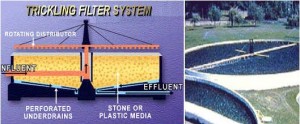

TYPES OF TRICKLING FILTERS
The Trickling filters are classified based on hydraulic or organic loading, as low rate trickling filter (LRTF), high rate trickling filter (HRTF) and Roughing Filter.
1 Low Rate Trickling Filter (LRTF)
The standard rate or Low rate trickling filters (LRTF) are relatively simple treatment units that normally produce a consistent effluent quality even with varying influent strength. They are generally not provided with recirculation of effluent. Depending upon the dosing system, wastewater is applied intermittently with rest periods which generally do not exceed five minutes at the designed rate of waste flow. With proper loadings the LRTF, including primary and secondary sedimentation units, should remove from 80 to 85 percent of the applied BOD. While there is some unloading or sloughing of solids at all times, the major unloadings usually occur several times a year for comparatively short Periods of time.
2 High Rate Trickling Filter (HRTF)
 The High Rate Trickling Filters (HRTF), have the same construction details, but the recirculation of effluent is provided.. Part of the settled treated effluent is pumped to the PST or to the filter. Recirculation of effluent is an essential and important feature of the HRTF. Thus the incoming wastewater is diluted and TSS concentrations are reduced. High-rate filters are usually characterized by higher hydraulic and organic loadings than low-rate filters. The higher BOD loading is accomplished by applying a larger volume of waste per unit surface area of the filter. One method of increasing the efficiency of a trickling filter is to incorporate recirculation. When recirculation is used, the hydraulic loading per unit area of filter media is increased. As a result, higher flow velocities will usually occur causing a more continuous and uniform sloughing of excess growths. High-rate trickling filters, including primary and secondary sedimentation, should, under normal operation, remove from 65 to 85 percent of the BOD of the wastewater.
The High Rate Trickling Filters (HRTF), have the same construction details, but the recirculation of effluent is provided.. Part of the settled treated effluent is pumped to the PST or to the filter. Recirculation of effluent is an essential and important feature of the HRTF. Thus the incoming wastewater is diluted and TSS concentrations are reduced. High-rate filters are usually characterized by higher hydraulic and organic loadings than low-rate filters. The higher BOD loading is accomplished by applying a larger volume of waste per unit surface area of the filter. One method of increasing the efficiency of a trickling filter is to incorporate recirculation. When recirculation is used, the hydraulic loading per unit area of filter media is increased. As a result, higher flow velocities will usually occur causing a more continuous and uniform sloughing of excess growths. High-rate trickling filters, including primary and secondary sedimentation, should, under normal operation, remove from 65 to 85 percent of the BOD of the wastewater.
3 Roughing Filter
Roughing filters are high rate type filters designed with plastic packing. In most cases roughing filters are used to treat wastewater prior to secondary treatment. One of the advantages of roughingfilter is low energy requirement for BOD removal of high strength wastewaters as compared to activated sludge process because the energy required is only for pumping the influent wastewater and recirculation flows
Design parameters for Trickling Filters
| Parameter | Low–rate filter |
High rate (stone media) filter |
High-rate (plastic media) filters |
Roughing filters (stone or plastic media) |
| Hydraulic load, m3/ m2 -dMLD/ha-d | 1 – 410 – 40 | 10 – 40100 – 400 , | 40 – 75400 – 750 | 40 – 200400 – 2000 |
| Organic load,kg BOD/ rn3– d | 0.10 – 0.25 | 0.40 – 2.4 | 0.6 – 3.0 | 1.2 – 3.0 |
| Recirculation ratio | 0 | 1.0 – 2.0 | 1.0 – 2.0 | 0 – 2.0 |
| Depth, m | 1.8 – 2.4 | 1.8 – 2.4 | 3.0 – 12.0 | 1.0 – 6.0 |
| Filter media | Rock, gravel | Rock, gravel | Plastics | Plastics |
| Efficiency of BOD removal, % | 80 – 90 | 50 – 90 | 60 – 90 | 40 – 70 |
| Power, kW/1000 m3 | 2 – 4 | 6 – 10 | 6 – 10 | 10 – 20 |
The effluent is nitrified to nitrate only and is thus less stable and the effluent BOD will be 30mg/L. To improve the quality of effluent a second stage filter may be provided. The first stage and second stage filters are arranged in series.
4 Two-Stage Trickling Filters
Two stage TF system with recirculation of effluent from SST is Two-stage TF system with intermediate settling tank (IST) to remove solids generated by the first filter, is most often used with high strength wastewater . Two-stage TF systems are also used where nitrification is required. The first-stage filter and intermediate clarifier reduces carbonaceous BOD, and nitrification takes place in the second stage
2 Responses to “TYPES OF TRICKLING FILTERS”
Leave a Reply






 LIKE TO GET UPDATES
LIKE TO GET UPDATES  TO GET EXPERT GUIDE
TO GET EXPERT GUIDE
good ANSWER TO MA QUESSSTION
Just the answer i was looking for… Keep it up.